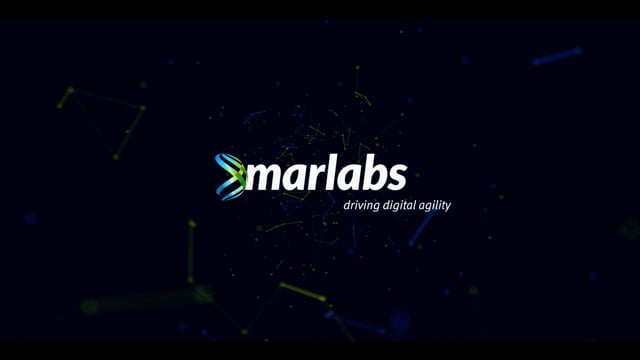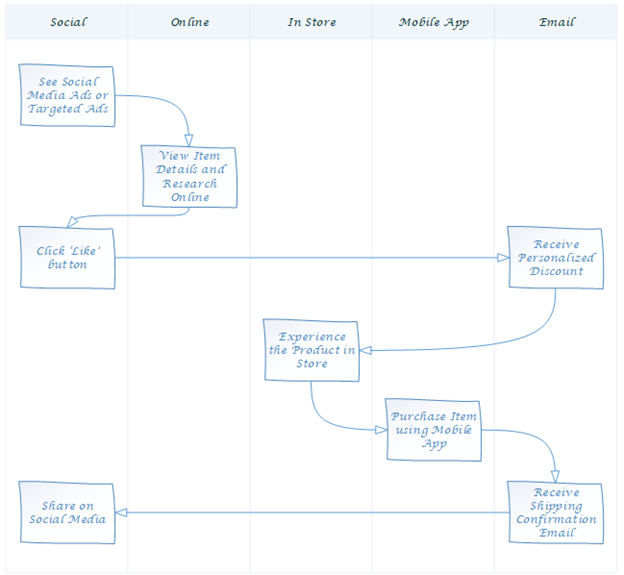In order to stay relevant in this new digital age of B2B and B2C eCommerce, it is important for businesses to anticipate the needs of the customer. Customers typically engage with a web site 70% into their buying journey after doing their own research using the internet. Most buying decisions are made prior to a customer’s interaction with your brand. Hence it is critical to leverage analytics and machine learning for gaining actionable insights and present to the customer, in real time, what they are looking for across all channels.
A customer may experience your brand from across several channels and hence the term ‘Omni Channel’. A product purchase journey of a customer may cut across multiple channels several times before he or she makes a purchase. A cross-channel commerce survey showed that over 78% of consumers today shop across multiple channels from online, mobile, and in the store.
The following diagram represents a sample customer journey during a product purchase.
Customers may use different channels and touchpoints to interact with your brands as they move from one to stage to another in their customer journey. A recent survey shows that over 80% of consumers research the product on their mobile device before purchasing a product. Understanding each stage in the customer journey is crucial in engaging your customers and helping them move from one to stage to another towards a desirable outcome and achieve your marketing objectives.
Digital Marketing is rapidly losing steam to a more holistic marketing concept called Experience Marketing. Experience Marketing focuses on understanding the user’s experience across all channels and provide personalized content to drive conversions out of users, such as purchasing relevant products. Personalization is key to achieving your long-term digital goals.
A Digital Relevancy Map helps you develop the most effective personalization strategy for supporting those experiences. It shows you how to create the most relevant content for your key customer segments.
Before you can create a Digital Relevancy Map and start delivering personalized content to customers, there are a number of steps involved in developing that strategy. Some of the key steps involved are described below:
Business Objectives
12ptIt all starts with defining your business objectives. Identify what are the key business objectives and how they can be measured. Create a list of Key Performance Indicators (KPIs) to measure them.
Digital Strategy
Define your digital strategy and see how it aligns with your business objectives. Create a list of KPIs to measure your digital strategy. One such KPI for an eCommerce platform is ‘Revenue’. By creating a digital goal associated to Revenue, you can calculate how much revenue your digital experiences influenced. Integration with your enterprise systems such as ERP and CRM is crucial in implementing this measurement strategy. Marketing Qualified Leads, Bounce Rate percentage etc. are examples of some of the KPIs that can be included in your measurement strategy. Inbound marketing techniques such as Search Engine Optimization (SEO) and pay-per-click advertising makes it easy for prospects to find you. Outbound marketing techniques, such as telemarketing and e-mail enables you to proactively educate prospects about your offerings.
Customer Segmentation
A customer segment is a group of visitors who share similar characteristics and may benefit from a similar user experience. Segments are used to target specific content to specific groups of users. Customer segmentation strategy should consist of Implicit Segmentation, which is driven from user’s behavior and Explicit Segmentation, which is based on historical data available in the system about that customer.
Customer Segmentation can be defined by dimensions such as Personas, Product Categories, Stage in the Journey, Industry Type etc. Personas are visitors/users of your digital channels that represent the needs of larger groups of users in terms of their behaviors, goals, needs and emotions in relation to their digital journeys. They act as a representation of real users and help guide decisions about functionality and user experience design that is essential for a good, user-centric design and predictive personalization.
Predictive personalization requires tagging content with profile cards. A profile card has different keys where each key is scored using a measure called engagement value based on user’s engagement with your digital channels. Based on the content consumed and engagement value that has accrued as a result, each visitor, including anonymous visitors can be automatically classified and associated to a user group or Persona he or she most closely matches. This information can then be used to dynamically change all or part of your digital content to show only what is most relevant to the user. Leverage Big Data Analytics combined with Artificial Intelligence and Machine Learning to better understand customer needs and their purchasing behavior to provide an effective customer experience through predictive personalization.
Customer Journey Mapping
The customer journey is a series of experiences that customers go through during their lifecycle including all interactions with your brand and organization. Most customer journeys follow a path like the one shown below…
Customer journey maps could be different from one customer segment to another. For example, in a B2B eCommerce scenario, a Purchase Employee may enter the customer journey in the ‘Awareness’ stage or ‘Research’ stage, whereas a Purchase Manager who is a decision maker may enter the journey in an ‘Evaluation’ stage after reading recommendations from the purchase employee.
Customer journey may involve repeated engagement through several stages until they finally become marketing qualified leads and customers. Understanding the customer journey is critical for effectively strategizing opportunities to engage with customers and enhance the customer experience.
Digital Relevancy Map
A Digital Relevancy Map captures the functionality and content that is appropriate for your important customer segments at each stage of their customer journey. It is critical for a focused content planning for your personalization strategy. The following table shows a sample format of a basic Digital Relevancy Map (DRM). A single DRM or multiple DRMs may be created for the top customer segments. Revising DRMs for your key customer segments should be part of the ongoing activities of the content team.
A unified platform such as Sitecore with its Experience Platform and Experience Commerce that combines Content, Commerce and Analytics enables marketers to get a single view of how your customer is experiencing your brand. Also, leverage the power of Azure cloud platform for Big Data Analytics combined with Artificial Intelligence and Machine Learning to get a 360 view of your customer’s data spread across multiple enterprise systems such as ERP, CRM or other databases. These actionable insights help to move your customers through their decision and buying journey more quickly by ensuring that they receive the right content, at the right time, in their preferred channel, and with the right call to action that anticipate their needs.











